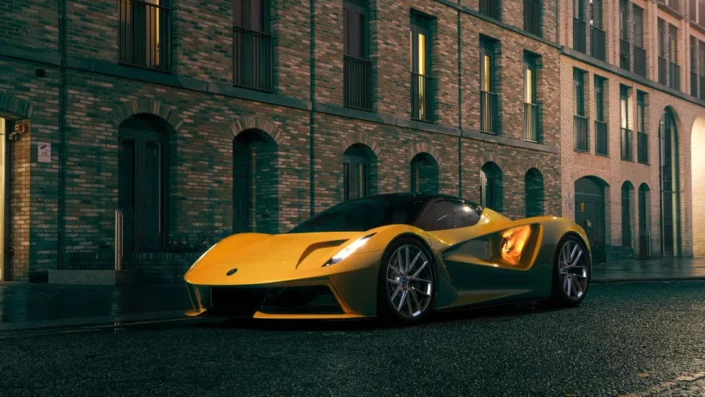Lotus Engineering commercial director Mark Stringer spoke with Andrew Wade about the iconic carmaker’s pivot to electrification.
When you’re sitting on three-quarters of a century of automotive heritage, fundamental changes to your brand can be a dangerous thing. In April 2021, Lotus announced that it would cease building internal combustion engine (ICE) cars, pledging to become fully electric by the late 2020s. For an iconic British marque whose identity is closely tied to Formula One and high performance sports cars, it was a bold move.
“I think it was 2018 when we made the call as a business,” Mark Stringer, commercial director of Lotus Engineering, told The Engineer. “We had no visibility of any premium or sporting brands really pushing electrification at all at that point.”
According to Stringer, the switch to electric was driven by a desire to go from a niche manufacturer of around 1,600 petrol-powered cars per year, to become a significant player in the luxury segment, delivering upwards of 100,000 premium EVs annually. Another major factor was undoubtedly the 2017 takeover of the company by Chinese auto giant Geely, a global leader in electrification.
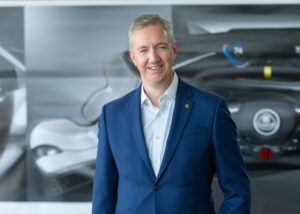
The first Lotus delivered as part of this new strategy was the Eletre, a crossover SUV built on a bespoke chassis known as the Electric Premium Architecture (EPA) platform. When The Engineer spoke with Stringer in 2023, the company had just launched the Emeya. A luxury ‘hyper GT’ built on the same EPA platform as Eletre, Emeya is set to compete with the Porsche Taycan, widely regarded as one of the best EVs money can buy.
As a salve for Lotus’s petrolhead fans, the company also released the Emira in 2022. Billed as the last Lotus powered by an ICE, the Emira is a final nod to the heritage that has made the Hethel brand a household name over the course of 75 years. But Stringer is clear on the direction that Lotus is now travelling.
“We want to be in that premium sporting BEV (battery electric vehicle) space,” he said.
“It’s been quite a journey. We’ve had to scale up our whole company in different ways. We’ve had to create new platforms. They’re not ICE platforms that we’re converting to make BEVs. They are all new, ground up, designed to be optimised around that single vision of what a BEV sports car – or lifestyle car in the case of Eletre and Emeya – should be.”
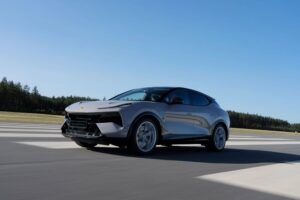
Branching out into the lifestyle segment has inevitably provoked some backlash, with the Eletre SUV singled out for particular ire, criticised from some quarters as not being a ‘real Lotus’. With a brand identity built on performance, handling and lightweighting – embellished through its long association with F1 – a pivot to lifestyle vehicles was always going to raise eyebrows amongst the Lotus faithful.
“I think before people could see the cars coming out, the Eletre and Emeya, there was some nervousness out there,” said Stringer. “Now the cars are coming out, people are really starting to get it.”
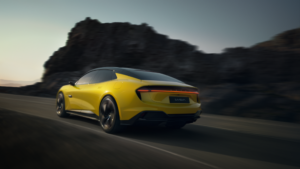
For anyone doubting Lotus’s commitment to high-end performance, the company has also been developing the Evija, a BEV hypercar targeting the upper echelons of the automotive pantheon. Delivering 1500kW/2012 hp through its four wheel-based motors, the Evija is claimed to be the world’s most powerful series production car, going from 0-62mph in under three seconds, and 0-186mph in 9.1 seconds.
Having been announced in 2019, the Evija has had somewhat of a bumpy production journey, with Covid and supply chain issues delaying delivery dates. However, the limited run of 130 vehicles is almost fully subscribed, which at roughly $2.3m a pop is welcome news for the Lotus coffers. Deliveries will begin this year and continue through 2024.
Unlike the Eletre and Emeya which are produced in Wuhan, China, the Evija is hand-built at Lotus’s spiritual home in Hethel, Norfolk. The carbon fibre tub that forms the core of Evija is created in a single shot process, which is technically challenging but brings a raft of advantages. According to Lotus, the 150kg tub provides enough inherent stability to allow peripheral engineering weight to be stripped back, delivering a light, stiff base that underpins Evija’s handling and performance.
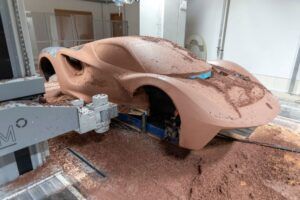
The most extreme embodiment of this is the Evija X, which debuted at the Nürburgring in June 2023. A heavily modified prototype with a huge swan-neck rear spoiler, the Evija X’s appearance at the Nürburgring sparked rumours that Lotus was chasing the EV lap record at the infamous track, seen by many as the ultimate accolade for high performance vehicles. Though Lotus has been relatively tight lipped on details, Stringer didn’t deny they were eyeing the record at the legendary 12.9-mile Nürburgring Nordschleife circuit.
“It’s an extremely well known track,” said Stringer. “We make a hypercar. It feels like the two things should go together.”
Design cues on the Evija have also informed Lotus on other, non-auto projects. The company has a long history developing Team GB Olympic track bikes, stretching as far back as Chris Boardman’s bike on which he won gold at Barcelona in 1992. Lotus once again helped develop the track bike for the recent Tokyo Olympics, and its design for the Paris 2024 bike has borrowed some of the Evija’s DNA.
“Those exact same processes, tools, techniques, materials, and indeed the people…were used on the Evija hypercar and the Team GB Olympic bike,” said Stringer.
One of the key areas of technology transfer between the two projects has been aerodynamics. The Evija’s striking frame, developed under the guidance of chief aerodynamicist Richard Hill, is based around the concept of ‘porosity’, whereby air flows through the structure as well as around it.
The front of the car acts like a mouth, gulping in air and creating huge downforce, while venturi tunnels toward the rear feed the wake ‘through’ the car, reducing drag. While the dynamics of a hypercar and a bicycle are obviously different, lessons from Evija have been applied to the Olympic bike, with Hill himself playing a key role in the Tokyo and Paris projects.
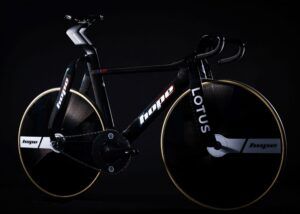
“We basically transposed that knowledge straight into our collaboration with British Cycling, saying ‘how do we do the same thing on a bike?’,” Stringer explained. “We spent lots of time in special bike wind tunnels of British Cycling with the same people just working out how you optimise those front forks to guide the air though the rider’s legs.
“So it’s not about having a really aerodynamic set of forks and then not worrying about it after that. It has to be forks, legs and then rear forks again as you guide the air all the way through this kind of multiple body process to get to the back, to make it as slippery as possible.”
According to Stringer, coming at the challenge from a slightly different perspective invariably provides an advantage.
“Not being bike engineers is what helps when we’re engineering a bike almost, because it’s not a normal bike,” he said.
At this summer’s Olympics, we’ll get to see if that advantage pays off.

